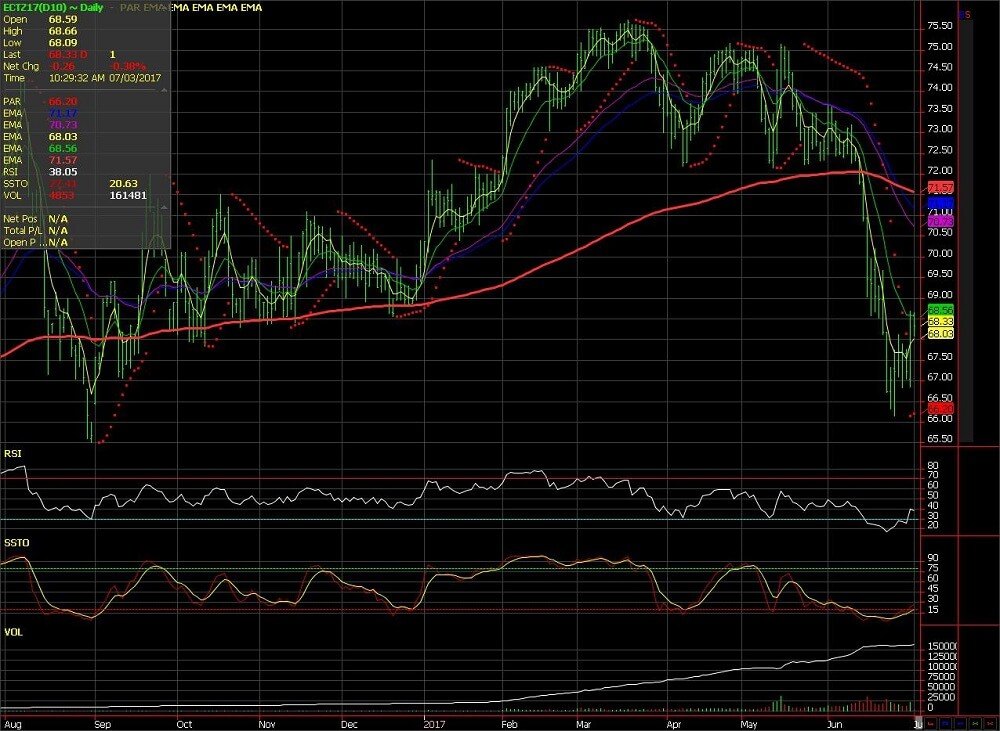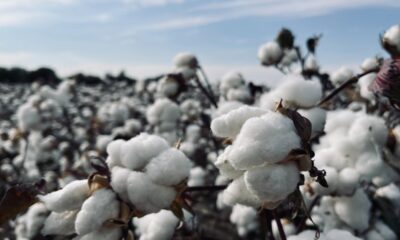Business
The commodities are on the move
While China may be the largest producer of cotton, the US may be the largest exporter.

Speaking of shirts, the cotton contract traded in commodities is what many clothes are made of. It is a staple fiber founded in the Old and New Worlds. As far back at 5000 BC, traces of cotton fiber have been excavated. The cotton crops require the sun, moderate rainfall and are planted anywhere from February to June each year. Harvest can take place anywhere between July and October here in the US.
The commodities are traded in specified contract sizes determined by the Pit Committee of the Exchanges. Cotton is a 50,000 lbs. contract with each Tick of .01 Cents = $5.00. It is offered in five trading months of March, May, July, October, and December. The good faith deposit or money put up to control one contract may fluctuate. It may be $2,530.00 currently but may be changed any moment by the Exchange according to the volatility, price movement and potential risk of the trade. The risk on an outright futures position may be unlimited, so many traders opt for a combined option and futures position to attempt to control the loss. Other traders may take an outright futures position with the use of a Stop Loss. Please note that certain market conditions may occur whereby a market may run a stop.
Traders or investors may look at both the fundamentals and the technical factors before determining whether they would like to enter into a position to buy or sell a market.

A chart on the December cotton contract. Photo © Leslie Burton
One may view the chart as a technically bullish set-up with consolidation points as well.
The Fundamentals are derived from last Friday’s USDA report citing India’s exports for the 2016/2017 season may be under the expectations or norm by 17 %. Demand, on the other hand, may be up at about $85 billion and may even increase to $160 billion by 2025. The USDA report estimated the US Acreage at 12.055 million acres while trade expectations were for 12.278 million acres.
The options on the futures contracts allow the trader to participate in the market without putting up margins if they are buying the option for their entry. The buyer of the options pays outright for the option in premium.
For example, one may purchase an 85.00 Call on December cotton for 0.17 or $85.00. Their total risk on the trade may be $85.00 plus commissions and fees. The option may be sold at a later date should the market increase in premium or the trader wish not to lose the whole option premium. The expiration of the option may be November 10th 2017 for the December cotton option. The thing about options is that it is a wasting asset with the time value eating away at the premium of the option. It is said that about 90% of the options expire worthless, so the buyer of the option has the numbers against him/her. The sellers of the options may have the numbers in their favor but must absorb enormous risk as an outright futures contract. They may put up margin. The volatility and the underlying price movement of the option may affect the premium as well increasing the premium with a positive movement or decreasing the premium with a negative movement. A trader may purchase a ‘Call’ option contract if they feel the market may go higher. If a trader feels that the market may trend lower, they may purchase a ‘Put’ option contract. The further out of the money the strike price (85.00), the more difficult it becomes to make money.
It is suggested to paper trade strategies and do plenty of research before entering into any new investment arena. There are often benefits to investors for diversifying their investment portfolio. Stock market fluctuations may be more balanced with other investment products non-correlated to the moves of a portfolio.
Good trading!
–
RISK DISCLOSURE:
THIS MATERIAL IS CONVEYED AS A SOLICITATION FOR ENTERING INTO A DERIVATIVES TRANSACTION.
THIS MATERIAL HAS BEEN PREPARED BY A DANIELS TRADING BROKER WHO PROVIDES RESEARCH MARKET COMMENTARY AND TRADE RECOMMENDATIONS AS PART OF HIS OR HER SOLICITATION FOR ACCOUNTS AND SOLICITATION FOR TRADES; HOWEVER, DANIELS TRADING DOES NOT MAINTAIN A RESEARCH DEPARTMENT AS DEFINED IN CFTC RULE 1.71. DANIELS TRADING, ITS PRINCIPALS, BROKERS, AND EMPLOYEES MAY TRADE IN DERIVATIVES FOR THEIR OWN ACCOUNTS OR FOR THE ACCOUNTS OF OTHERS. DUE TO VARIOUS FACTORS (SUCH AS RISK TOLERANCE, MARGIN REQUIREMENTS, TRADING OBJECTIVES, SHORT TERM VS. LONG TERM STRATEGIES, TECHNICAL VS. FUNDAMENTAL MARKET ANALYSIS, AND OTHER FACTORS) SUCH TRADING MAY RESULT IN THE INITIATION OR LIQUIDATION OF POSITIONS THAT ARE DIFFERENT FROM OR CONTRARY TO THE OPINIONS AND RECOMMENDATIONS CONTAINED THEREIN.
PAST PERFORMANCE IS NOT NECESSARILY INDICATIVE OF FUTURE PERFORMANCE. THE RISK OF LOSS IN TRADING FUTURES CONTRACTS OR COMMODITY OPTIONS CAN BE SUBSTANTIAL, AND THEREFORE INVESTORS SHOULD UNDERSTAND THE RISKS INVOLVED IN TAKING LEVERAGED POSITIONS AND MUST ASSUME RESPONSIBILITY FOR THE RISKS ASSOCIATED WITH SUCH INVESTMENTS AND FOR THEIR RESULTS.
YOU SHOULD CAREFULLY CONSIDER WHETHER SUCH TRADING IS SUITABLE FOR YOU IN LIGHT OF YOUR CIRCUMSTANCES AND FINANCIAL RESOURCES. YOU SHOULD READ THE “RISK DISCLOSURE” ACCESSED BY THE LINK BELOW. DANIELS TRADING IS NOT AFFILIATED WITH NOR DOES IT ENDORSE ANY TRADING SYSTEM, NEWSLETTER OR OTHER SIMILAR SERVICE. DANIELS TRADING DOES NOT GUARANTEE OR VERIFY ANY PERFORMANCE CLAIMS MADE BY SUCH SYSTEMS OR SERVICES.

-

 Impact Investing2 weeks ago
Impact Investing2 weeks agoEU Eases CO2 Tax Burden on SMEs with Revised CBAM Rules
-

 Fintech13 hours ago
Fintech13 hours agoRobinhood Expands to Europe with Tokenized Stocks and Perpetual Futures
-

 Business1 week ago
Business1 week agoAmerica’s Debt Spiral: A $67 Trillion Reckoning Looms by 2035
-

 Crowdfunding5 days ago
Crowdfunding5 days agoTasty Life Raises €700,000 to Expand Pedol Brand and Launch Food-Tech Innovation

























You must be logged in to post a comment Login